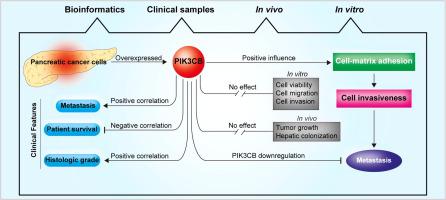Journal of Advanced Research ( IF 11.4 ) Pub Date : 2021-02-17 , DOI: 10.1016/j.jare.2021.02.002 Jianhua Qu 1, 2 , Biao Zheng 1, 3 , Kenoki Ohuchida 3, 4 , Haimin Feng 3 , Stephen Jun Fei Chong 5 , Xianbin Zhang 1 , Rui Liang 1 , Zhong Liu 1 , Kengo Shirahane 3 , Kazuhiro Mizumoto 3, 6 , Peng Gong 1, 7 , Masafumi Nakamura 3

|
Introduction
Pancreatic adenocarcinoma (PAAD) is an aggressive malignancy, with a major mortality resulting from the rapid progression of metastasis. Unfortunately, no effective treatment strategy has been developed for PAAD metastasis to date. Thus, unraveling the mechanisms involved in PAAD metastatic phenotype may facilitate the treatment for PAAD patients.
Objectives
PIK3CB is an oncogene implicated in cancer development and progression but less is known about whether PIK3CB participates in PAAD metastasis. Therefore, the objective of this study is to explore the mechanism(s) of PIK3CB in PAAD metastasis.
Methods
In our study, we examined the PIK3CB expression pattern using bioinformatic analysis and clinical material derived from patients with PAAD. Subsequently, a series of biochemical experiments were conducted to investigate the role of PIK3CB as potential mechanism(s) underlying PAAD metastasis in vivo using nude mice and in vitro using cell lines.
Results
We observed that PIK3CB was involved in PAAD progression. Notably, we identified that PIK3CB was involved in PAAD metastasis. Downregulation of PIK3CB significantly reduced PAAD metastatic potential in vivo. Furthermore, a series of bioinformatic analyses showed that PIK3CB was involved in cell adhesion in PAAD. Notably, PIK3CB depletion inhibited invasion potential specifically via suppressing cell adhesion to collagen I in PAAD cells.
Conclusion
Collectively, our findings indicate that PIK3CB is involved in PAAD metastasis through cell-matrix adhesion. We proposed that PIK3CB is a potential therapeutic target for PAAD therapy.
中文翻译:

PIK3CB通过调节胰腺癌中细胞与胶原蛋白I的粘附参与转移
介绍
胰腺腺癌 (PAAD) 是一种侵袭性恶性肿瘤,由于转移的快速进展,死亡率很高。不幸的是,迄今为止,还没有针对 PAAD 转移制定有效的治疗策略。因此,揭示 PAAD 转移表型所涉及的机制可能有助于 PAAD 患者的治疗。
目标
PIK3CB是一种与癌症发展和进展有关的癌基因,但对于 PIK3CB 是否参与 PAAD 转移知之甚少。因此,本研究的目的是探讨 PIK3CB 在 PAAD 转移中的作用机制。
方法
在我们的研究中,我们使用生物信息学分析和来自 PAAD 患者的临床材料检查了 PIK3CB 表达模式。随后,进行了一系列生化实验,以研究 PIK3CB 作为在体内使用裸鼠和体外使用细胞系进行 PAAD 转移的潜在机制的作用。
结果
我们观察到 PIK3CB 参与 PAAD 进展。值得注意的是,我们发现 PIK3CB 参与了 PAAD 转移。PIK3CB的下调显着降低了体内PAAD 转移潜能。此外,一系列生物信息学分析表明,PIK3CB参与了 PAAD 中的细胞粘附。值得注意的是,PIK3CB耗竭通过抑制 PAAD 细胞中细胞与胶原蛋白 I 的粘附来抑制侵袭潜力。
结论
总的来说,我们的研究结果表明 PIK3CB 通过细胞 - 基质粘附参与 PAAD 转移。我们提出 PIK3CB 是 PAAD 治疗的潜在治疗靶点。











































 京公网安备 11010802027423号
京公网安备 11010802027423号